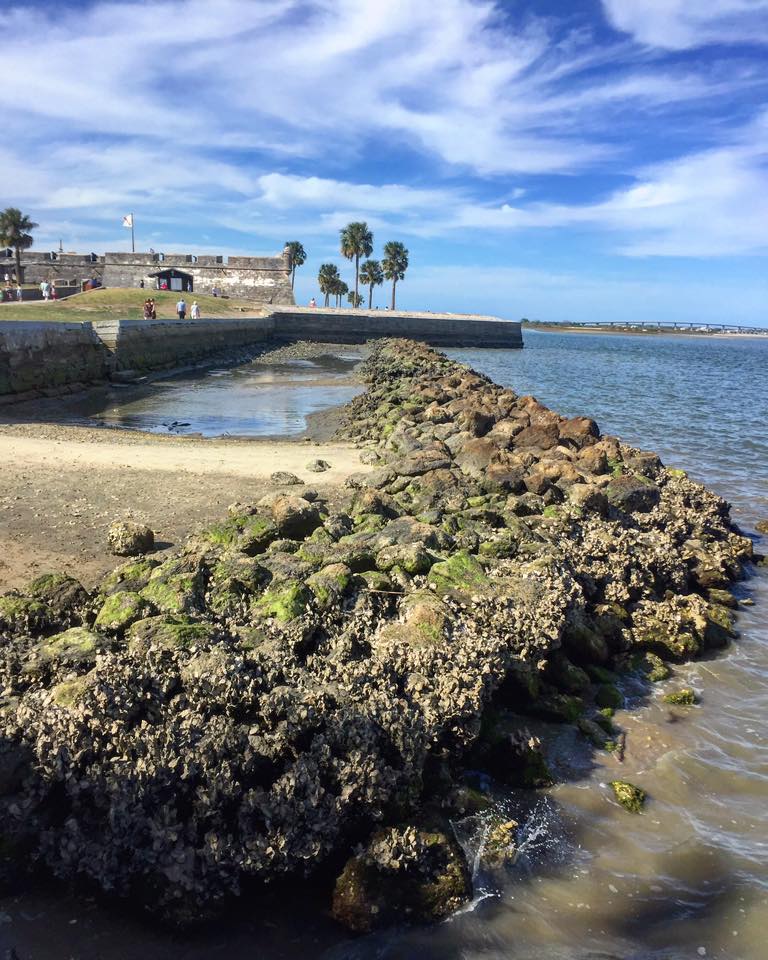By Lauren Schroeder | gargoyle@flagler.edu

At Castillo De San Marcos, a thick wall of coquina and oysters line the shore. The combination of coquina and oyster shells act as a natural barrier against wave energy and flooding for both the fort and the historic sea wall that protects it. As boat wakes and waves batter against the shore, the coquina and oyster decrease wave energy and settle sediment, therefore reducing flooding.
Rising sea levels and the flooding that follows is becoming a pressing issue for coastal property owners in St. Augustine, but not only the residents are being affected.
According to the St. Augustine Record, the city is “one of three communities that the state [of Florida] is studying for how vulnerable they are to sea-level rise and how they can prepare.”
In most cases of preparation, local governments and the residents’ main concern is about property loss, however, property is not the only thing at stake. Melissa Southwell, a professor of natural sciences at Flagler College, stressed the importance of habitat loss and the impact rising sea levels and flooding have on the existing ecosystems.
“There is habitat loss with sea-level rise, however, most of the focus is property and loss of finances. Scientists are worried about that habitat loss,” Southwell said.
As sea levels continue to rise and flooding worsens, man-made solutions are being implemented along the coastline of St. Augustine. One of these solutions is the construction of seawalls.
Jessica Veenstra, a natural science professor at Flagler College emphasized how even though man-made solutions such as seawalls manage flooding and rising sea levels, they interrupt the already existing ecosystems.
In a typical coastal ecosystem, there is a “gradual sloping shoreline that would have certain plants at high elevations, [that lead] to spartina, [then to] to mud flats,” Veenstra said. “[A] hard solid seawall breaks that transition; spartina won’t grow, oysters won’t grow as well, and the fish will be affected that use spartina and oysters for hiding and hunting.”
The growth of oysters and spartina have proven to be an extremely effective way to naturally combat rising sea levels and flooding without disrupting surrounding ecosystems. Therefore, if communities utilize these alternative natural methods, seawalls may not even be needed, letting ecosystems flourish and naturally protect our shorelines.
“At the fort, there is a line of coquina that borders the front of the seawall with oysters to act as a living shoreline,” Veenstra said.
In St. Augustine specifically, oysters have become a main line of defense against rising sea levels by decreasing wave energy.
“The oyster shells increase the friction that the waves experience as it passes over the oysters, dissipating the incoming wave energy. This slows the water down and reduces the wave’s ability to erode the shoreline,” Veenstra said.
The GTM Research Reserve is working in partnership with engineers from University of Florida to figure out how oysters can be used to decrease wave energy.
“We have simple, rectangular beds, and they’re creating spherical beds called gabions. “[This is] another way to grow oysters and improve quality,” Veenstra said.
Gabions are baskets or cages that are filled with oysters and act as a natural barrier against wave energy and flooding.
Not only do oysters work to decrease wave energy, they also act as filter feeders. Oysters take in large amounts of water and filter it by consuming the algae, phytoplankton and other particles that would otherwise decrease water quality.
Another method used to decrease wave energy is the planting and growth of spartina grass. Properly known as spartina alterniflora, this type of smooth cordgrass is commonly found in marshes and was introduced into the United States in order to decrease erosion along shorelines.
“Once it’s established and as the waves move through it, the spartina causes friction, slows waves down and settles sediment. Anytime we can get the sediment to settle down helps the shoreline,” Veenstra said.
Though many man-made structures have already been implemented, research being conducted on living shorelines may be the future for rising sea levels and flooding.
“We can use naturally existing ways to deal with increased wave energy,” Veenstra said.
By using these already existing natural shorelines, communities can decrease wave energy without disrupting or destroying already existing ecosystems.
“There’s a balance, we have a beautiful city that we need to protect, but we also have a beautiful ecosystem that needs to be protected too,” Veenstra said.



Be the first to comment on "Combatting rising seas with alternative methods"